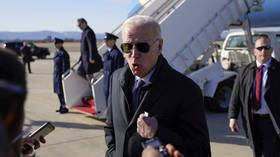The ‘Chinese spy balloon’ elevates US paranoia to lofty new heights

Over the past few days, the US succumbed to a political frenzy over a Chinese high-altitude balloon, which Beijing says is designed to monitor weather, but which American officials dubbed a “spy balloon”.
Use of the term “spy” to describe it quickly became mainstream, but it should be treated with caution given the US often uses that word to describe things it tends to dislike from China, whether or not there’s any evidence, for example, as we discussed last week, fridges.
The world looked on as the US descended into a self-orchestrated delirium, which ultimately resulted in President Joe Biden issuing the order to shoot the balloon down over South Carolina. For him, it was purely a matter of domestic political standing, as hawkish Republicans derided him as weak for his initial decision to leave the balloon alone out of caution.
It is very telling that after the “spy balloon” was shot down, unnamed Pentagon officials told American media that similar aircraft entered US airspace three times during the Donald Trump administration. Apparently, no-one thought to inform the public about them until they could be used to make Biden look better in comparison. And of course, “unnamed Pentagon officials” are the most convenient sources, generating headlines that shape public opinion and political debate without the need for evidence or accountability.
In the US, political debate pertaining to China is broken, unhinged to the point that it is impossible to have a rational or modest conversation about the topic in the political arena without descending into Red Scare-worthy hysteria and wild paranoia. If you followed the “conversation” and the calls to action, you’d think China committed a large-scale atrocity against the US that demanded immediate retaliation.
What does that mean? It means those who seek to ramp up tensions with China have control of the US debate to the point that it is detrimental to the administration, and it is thus impossible for America to act reasonably in its foreign policy with China. There’s enough evidence of that already. The Biden administration is, to some extent, a passenger in the toxic anti-Beijing foreign policy momentum which Trump and his allies created. There’s little Biden can do about it even if he wanted to, so for China, attempting good faith diplomacy with the US is a waste of time.
American foreign policy works through the deliberate promulgation of mass hysteria targeted at “official enemies”. The institutions of state, combined with the media, are adept at creating an atmosphere of immense fear, threat and paranoia towards anyone who is an opponent of the US, a legacy which began with McCarthyism in the Cold War. This fearmongering is often weighted on falsehoods, rather than evidence, and the scale of the threats are almost always exaggerated. The claims that Saddam Hussein had weapons of mass destruction and that Russia interfered in the US selection, are two contemporary examples.
While US foreign policy works through bipartisan consensus, these paranoid narratives are jumped on by politicians who often exaggerate claims that their opponents are being influenced, infiltrated or acting to appease the given enemy, for domestic political point-scoring, as in the bogus “Trump-Russia collusion” stories. They mix hysterical foreign policy narratives with deadly domestic partisan divides, and the product of it all is a dangerously unstable foreign policy which is predisposed towards hawkishness, because perceived reason or compromise with the “enemy” becomes a domestic political liability.
On the issue of China, this has become a serious problem. As the balloon story shows, all things related to China now serve to amplify paranoia in the US. While these narratives have been carefully selected in order to manufacture consent for US sanctions and technology embargos on China, such as Huawei, they have become so deeply saturated that it has allowed many political figures to see an advantage in embracing a full-on Cold War agenda and to extend that paranoia to anything, such as, for example, TikTok.
And in this environment, how is it possible to ever find balance in the relationship with China? When the hostility is plentiful from all levels of government, irrespective of political party, any attempts to mend or fix the relationship with China can be derailed by those eager to dramatically ramp up tensions or provoke Beijing whenever they get the chance. Another example was Nancy Pelosi’s visit to Taiwan, and the next will be Kevin McCarthy’s visit. These deliberately staged confrontations force the administration’s hand to act in order to save face, and make any kind of diplomacy with Beijing politically costly.
What this shows is that the Biden administration is not really in control at all. In fact, it has no leadership, no innovative or courageous thinking, and has just gone with the extremely hawkish flow on almost every foreign policy issue. This is ironic given Blinken framed his visit to Beijing as “managing” the competition between the two powers, when in fact the destabilizing, aggressive and unhinged behaviour is coming plainly from one side.
This saga paints an extremely pessimistic vista of the path ahead for US-China relations, because even though it is only a balloon, it demonstrates how unhinged the US political climate about China has become, and how the US President has neither control over, nor ability to manage, it. The White House is making decisions based on impulse and popular talking points, not national interest.
The statements, views and opinions expressed in this column are solely those of the author and do not necessarily represent those of RT.














